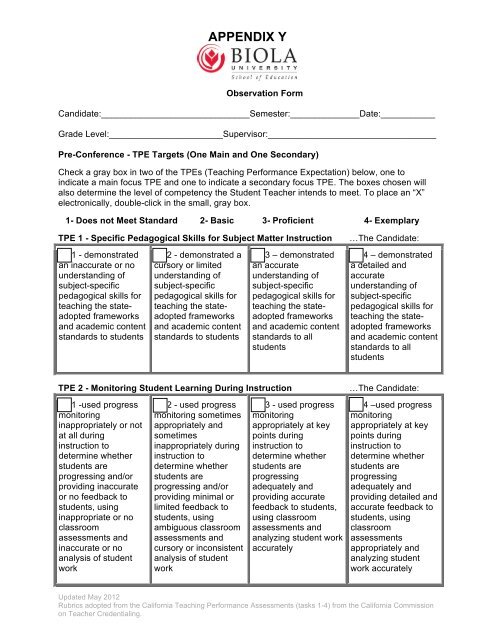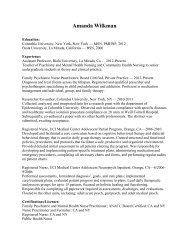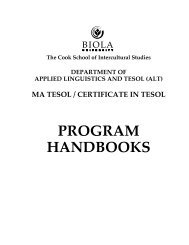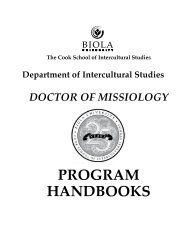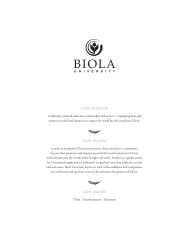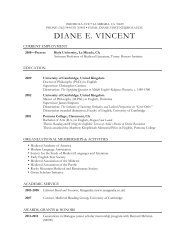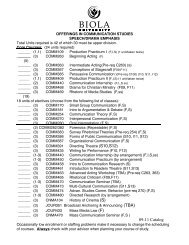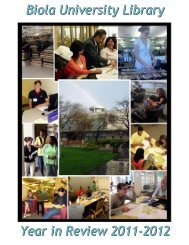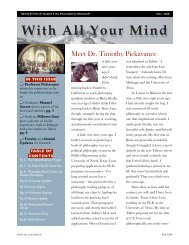Appendix Y- Observation Form
Appendix Y- Observation Form
Appendix Y- Observation Form
Create successful ePaper yourself
Turn your PDF publications into a flip-book with our unique Google optimized e-Paper software.
APPENDIX Y<br />
<strong>Observation</strong> <strong>Form</strong><br />
Candidate:______________________________Semester:______________Date:___________<br />
Grade Level:_______________________Supervisor:__________________________________<br />
Pre-Conference - TPE Targets (One Main and One Secondary)<br />
Check a gray box in two of the TPEs (Teaching Performance Expectation) below, one to<br />
indicate a main focus TPE and one to indicate a secondary focus TPE. The boxes chosen will<br />
also determine the level of competency the Student Teacher intends to meet. To place an “X”<br />
electronically, double-click in the small, gray box.<br />
1- Does not Meet Standard 2- Basic 3- Proficient 4- Exemplary<br />
TPE 1 - Specific Pedagogical Skills for Subject Matter Instruction …The Candidate:<br />
1 - demonstrated<br />
an inaccurate or no<br />
understanding of<br />
subject-specific<br />
pedagogical skills for<br />
teaching the stateadopted<br />
frameworks<br />
and academic content<br />
standards to students<br />
2 - demonstrated a<br />
cursory or limited<br />
understanding of<br />
subject-specific<br />
pedagogical skills for<br />
teaching the stateadopted<br />
frameworks<br />
and academic content<br />
standards to students<br />
3 – demonstrated<br />
an accurate<br />
understanding of<br />
subject-specific<br />
pedagogical skills for<br />
teaching the stateadopted<br />
frameworks<br />
and academic content<br />
standards to all<br />
students<br />
4 – demonstrated<br />
a detailed and<br />
accurate<br />
understanding of<br />
subject-specific<br />
pedagogical skills for<br />
teaching the stateadopted<br />
frameworks<br />
and academic content<br />
standards to all<br />
students<br />
TPE 2 - Monitoring Student Learning During Instruction …The Candidate:<br />
1 -used progress<br />
monitoring<br />
inappropriately or not<br />
at all during<br />
instruction to<br />
determine whether<br />
students are<br />
progressing and/or<br />
providing inaccurate<br />
or no feedback to<br />
students, using<br />
inappropriate or no<br />
classroom<br />
assessments and<br />
inaccurate or no<br />
analysis of student<br />
work<br />
2 - used progress<br />
monitoring sometimes<br />
appropriately and<br />
sometimes<br />
inappropriately during<br />
instruction to<br />
determine whether<br />
students are<br />
progressing and/or<br />
providing minimal or<br />
limited feedback to<br />
students, using<br />
ambiguous classroom<br />
assessments and<br />
cursory or inconsistent<br />
analysis of student<br />
work<br />
3 - used progress<br />
monitoring<br />
appropriately at key<br />
points during<br />
instruction to<br />
determine whether<br />
students are<br />
progressing<br />
adequately and<br />
providing accurate<br />
feedback to students,<br />
using classroom<br />
assessments and<br />
analyzing student work<br />
accurately<br />
4 –used progress<br />
monitoring<br />
appropriately at key<br />
points during<br />
instruction to<br />
determine whether<br />
students are<br />
progressing<br />
adequately and<br />
providing detailed and<br />
accurate feedback to<br />
students, using<br />
classroom<br />
assessments<br />
appropriately and<br />
analyzing student<br />
work accurately<br />
Updated May 2012<br />
Rubrics adopted from the California Teaching Performance Assessments (tasks 1-4) from the California Commission<br />
on Teacher Credentialing.
TPE 3 - Interpretation and Use of Assessment …The Candidate:<br />
1 - used<br />
assessment results<br />
inappropriately or not<br />
at all to determine<br />
student progress and<br />
to plan instruction,<br />
providing inaccurate<br />
or no feedback, to<br />
students and/or to<br />
their families about<br />
students academic<br />
strengths and areas<br />
for growth in relation<br />
to the learning goals<br />
2 - used<br />
assessment results<br />
both appropriately and<br />
inappropriately to<br />
determine student<br />
progress and to plan<br />
instruction, providing<br />
minimal or limited<br />
feedback, to students<br />
and/or to their families,<br />
about student<br />
academic strengths<br />
and areas for growth in<br />
relation to the learning<br />
goals<br />
2<br />
3 - used<br />
assessment results<br />
appropriately to<br />
determine student<br />
progress and to plan<br />
instruction, providing<br />
accurate feedback, to<br />
students and/or to their<br />
families, about student<br />
academic strengths<br />
and areas for growth in<br />
relation to the learning<br />
goals<br />
4 - used<br />
assessment results<br />
accurately and<br />
appropriately to<br />
determine student<br />
progress and to plan<br />
instruction, providing<br />
detailed and accurate<br />
feedback, to students<br />
and/or to their<br />
families, about<br />
student academic<br />
strengths and areas<br />
for growth in relation<br />
to the learning goals<br />
TPE 4: Making Content Accessible …The Candidate:<br />
1 -used<br />
developmentally<br />
inappropriate or no<br />
instructional strategies<br />
and activities<br />
according to purpose<br />
and lesson content,<br />
making inappropriate<br />
or no plans for<br />
students who have<br />
special needs or<br />
abilities<br />
2 - used ambiguous<br />
or inconsistent<br />
strategies and<br />
activities according to<br />
purpose and lesson<br />
content, making<br />
inconsistent or minimal<br />
plans for students who<br />
have special needs or<br />
abilities<br />
3 - used<br />
developmentally<br />
appropriate<br />
instructional strategies<br />
and activities<br />
according to purpose<br />
and lesson content,<br />
making appropriate<br />
plans for students who<br />
have special needs or<br />
abilities<br />
4 - used relevant<br />
and developmentally<br />
appropriate<br />
instructional strategies<br />
and activities<br />
according to purpose<br />
and lesson content,<br />
making relevant and<br />
appropriate plans for<br />
students who have<br />
special needs or<br />
abilities<br />
TPE 5 - Student Engagement …The Candidate:<br />
1 - ensured the<br />
active and equitable<br />
participation of few or<br />
no students<br />
2 - ensured the<br />
active and equitable<br />
participation of some<br />
students<br />
3 - ensured the<br />
active and equitable<br />
participation of most<br />
students<br />
4 - ensured the<br />
active and equitable<br />
participation of all<br />
students
TPE 6 - Developmentally Appropriate Teaching Practices …The Candidate:<br />
1 - adapted<br />
inappropriate or no<br />
instructional strategies<br />
to provide access to<br />
the state-adopted<br />
academic content<br />
standards for students<br />
or state-adopted<br />
framework(s)<br />
2 - adapted<br />
instructional strategies<br />
to provide access to<br />
the state-adopted<br />
academic content<br />
standards for students<br />
or state-adopted<br />
framework(s) in an<br />
ambiguous or<br />
inconsistent manner<br />
3<br />
3 - adapted<br />
appropriate<br />
instructional strategies<br />
to provide access to<br />
the state-adopted<br />
academic content<br />
standards for students<br />
or state-adopted<br />
framework(s) for all<br />
students<br />
4 – adapted<br />
relevant and<br />
appropriate<br />
instructional strategies<br />
to provide access to<br />
the state-adopted<br />
academic content<br />
standards for students<br />
or state-adopted<br />
framework(s) for all<br />
students<br />
TPE 7 - Teaching English Learners …The Candidate:<br />
1 - drew upon<br />
irrelevant or no<br />
information about<br />
students’<br />
backgrounds and prior<br />
learning, including<br />
students’ assessed<br />
levels of literacy in<br />
English and their first<br />
languages, as well as<br />
their proficiency in<br />
English, for planning,<br />
and/or allowing<br />
students to express<br />
meaning, including in<br />
their first language,<br />
knowing and applying<br />
inappropriate or no<br />
instructional practices<br />
for English Language<br />
Development<br />
2 -drew upon<br />
minimal or cursory<br />
information about<br />
students’ backgrounds<br />
and prior learning,<br />
including students’<br />
assessed levels of<br />
literacy in English and<br />
their first languages,<br />
as well as their<br />
proficiency in English,<br />
for planning, and/or<br />
allowing students to<br />
express meaning,<br />
including in their first<br />
language, having a<br />
limited knowledge<br />
and/or ambiguous<br />
application of<br />
instructional practices<br />
for English Language<br />
Development<br />
3 –drew upon<br />
relevant information<br />
about students’<br />
backgrounds and prior<br />
learning, including<br />
students’ assessed<br />
levels of literacy in<br />
English and their first<br />
languages, as well as<br />
their proficiency in<br />
English, for planning,<br />
and allowing students<br />
to express meaning,<br />
including in their first<br />
language, knowing<br />
and applying<br />
appropriate<br />
instructional practices<br />
for English Language<br />
Development<br />
4 -drew upon<br />
detailed and relevant<br />
information about<br />
students’<br />
backgrounds and prior<br />
learning, including<br />
students’ assessed<br />
levels of literacy in<br />
English and their first<br />
languages, as well as<br />
their proficiency in<br />
English, for planning,<br />
and allowing students<br />
to express meaning,<br />
including in their first<br />
language, knowing<br />
and applying relevant<br />
and appropriate<br />
instructional practices<br />
for English Language<br />
Development
TPE 8 - Learning About Students …The Candidate:<br />
1 - used<br />
inappropriate or no<br />
methods to obtain<br />
information about<br />
selected students that<br />
may influence<br />
instruction, obtaining<br />
irrelevant or no<br />
information about<br />
selected students<br />
such as linguistic<br />
background;<br />
academic language<br />
abilities, content<br />
knowledge, and skills;<br />
physical, social, and<br />
emotional<br />
development; cultural<br />
and health<br />
considerations; and<br />
interests<br />
2 - used limited<br />
methods to obtain<br />
information about<br />
selected students that<br />
may influence<br />
instruction, obtaining<br />
cursory information<br />
about selected<br />
students such as<br />
linguistic background;<br />
academic language<br />
abilities, content<br />
knowledge, and skills;<br />
physical, social, and<br />
emotional<br />
development; cultural<br />
and health<br />
considerations; and<br />
interests<br />
4<br />
3 - used relevant<br />
methods to obtain<br />
information about<br />
selected students that<br />
may influence<br />
instruction, obtaining<br />
detailed and relevant<br />
information about<br />
selected students such<br />
as linguistic<br />
background; academic<br />
language abilities,<br />
content knowledge,<br />
and skills; physical,<br />
social, and emotional<br />
development; cultural<br />
and health<br />
considerations; and<br />
interests<br />
4 - used relevant<br />
and appropriate<br />
methods to obtain<br />
information about<br />
selected students that<br />
may influence<br />
instruction, obtaining<br />
detailed and relevant<br />
information about<br />
selected students<br />
such as linguistic<br />
background;<br />
academic language<br />
abilities, content<br />
knowledge, and skills;<br />
physical, social, and<br />
emotional<br />
development; cultural<br />
and health<br />
considerations; and<br />
interests<br />
TPE 9 - Instructional Planning …The Candidate:<br />
1 – planned<br />
inappropriate or no<br />
instruction related to<br />
the content area and<br />
subject matter to be<br />
taught and/or not in<br />
accordance with<br />
state-adopted student<br />
academic content<br />
standards for students<br />
or state-adopted<br />
framework(s)<br />
selecting or adapting<br />
inappropriate or no<br />
instructional strategies<br />
and student activities<br />
that assist students to<br />
achieve learning goals<br />
or meet students’<br />
needs<br />
2 - planned<br />
instruction that is not<br />
clearly or coherently<br />
related to the content<br />
area and subject<br />
matter to be taught<br />
and/or is minimally in<br />
accordance with stateadopted<br />
academic<br />
content standards for<br />
students or stateadopted<br />
framework(s)<br />
selecting or adapting<br />
instructional strategies<br />
and student activities<br />
that minimally assist<br />
students in achieving<br />
learning goals or that<br />
are inconsistent in<br />
meeting students’<br />
needs<br />
3 - planned<br />
appropriate instruction<br />
in relation to the<br />
content area and<br />
subject matter to be<br />
taught and in<br />
accordance with stateadopted<br />
academic<br />
content standards for<br />
students or stateadopted<br />
framework(s)<br />
selecting or adapting<br />
appropriate<br />
instructional strategies<br />
and student activities<br />
that assist students to<br />
achieve learning goals<br />
and meet students’<br />
needs<br />
4 - planned<br />
relevant and<br />
appropriate<br />
instruction in relation<br />
to the content area<br />
and subject matter to<br />
be taught and in<br />
accordance with<br />
state-adopted<br />
academic content<br />
standards for<br />
students or stateadopted<br />
framework(s),<br />
selecting or adapting<br />
relevant and<br />
appropriate<br />
instructional<br />
strategies and student<br />
activities<br />
that assist students to<br />
achieve learning<br />
goals and meet all<br />
students’ needs
TPE 10 - Instructional Time …The Candidate:<br />
1 - allocated<br />
instructional time<br />
inappropriately,<br />
establishing<br />
inappropriate or no<br />
procedures for routine<br />
tasks and management<br />
of transitions<br />
2 – both<br />
appropriately and<br />
inappropriately allocated<br />
instructional time,<br />
establishing inconsistent<br />
or minimal procedures<br />
for routine tasks and<br />
management of<br />
transitions<br />
5<br />
3 - allocated<br />
instructional time<br />
appropriately,<br />
establishing appropriate<br />
procedures for routine<br />
tasks and managing<br />
transitions to maximize<br />
instructional time<br />
4 - allocated<br />
instructional time<br />
appropriately,<br />
establishing clear and<br />
appropriate procedures<br />
for routine tasks and<br />
managing transitions to<br />
maximize instructional<br />
time<br />
TPE 11 - Social Environment …The Candidate:<br />
1 - developed and<br />
maintained<br />
inappropriate or no<br />
expectations for<br />
academic and social<br />
behavior, creating a<br />
climate that is<br />
inappropriate for<br />
learning<br />
Pre-Conference Questions:<br />
<strong>Observation</strong> Evidence:<br />
Evidence of Student Learning:<br />
Post-<strong>Observation</strong> Conference<br />
Areas of Strength:<br />
Next Steps:<br />
2 - developed and<br />
maintained ambiguous or<br />
inconsistent expectations<br />
for academic and social<br />
behavior, creating a<br />
climate that is sometimes<br />
appropriate for learning<br />
3 - developed and<br />
maintained appropriate<br />
expectations for<br />
academic and social<br />
behavior, creating and<br />
maintaining a positive<br />
climate for learning<br />
4 - developed and<br />
maintained clear and<br />
appropriate expectations<br />
for academic and social<br />
behavior, creating and<br />
maintaining a positive<br />
climate for learning<br />
Attach your lesson plan here at the end of the document. This must be sent to Supervisor at least<br />
48 hours prior to observation.


